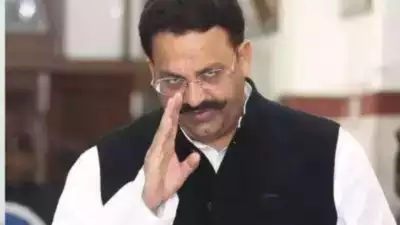VARANASI: Imprisoned mafia gangster Mukhtar Ansari has been granted 10 years’ detainment and a penalty of Rs 5 lakh by the MP-MLA court of Ghazipur in a 2010 Gangsters Act case.
Mukhtar’s immediate partner and co-charged Sonu Yadav was granted five years of detainment and a penalty of Rs 2 lakhs.
This is Ansari’s 6th conviction since September 2022.
The previous five-time MLA has proactively been granted a life term in the 1991 Awadhesh Rai murder case and 10 years’ detainment in two additional cases.
Ansari faces 61 criminal cases In the wake of articulating Mukhtar and Sonu’s blameworthy on Thursday, additional session judge-III (MP-MLA) Arvind Kumar Mishra in his 30-page judgment on Friday articulated the quantum of the sentence.
Extra locale government counsel (criminal), Ghazipur, Neeraj Srivastava said that Ansari is staying in Banda prison and showed up under the steady gaze of the court through video-conferencing. Sonu, who was taken under care following his conviction for the situation on Thursday, was delivered under the steady gaze of the court by police, he added.
This Gangster Act was lodged in 2010 after Mukhtar was bolder for killing a teacher Kanpil Deo Singh in the Karanda block of the region in 2009. Around the same time, one Meer Hasan had likewise stopped a murder case of evidence against him. The Ghazipur Police booked Ansari under the Criminals Follow-up based on these two cases.
As per Mukhtar’s legal counselor Liyaqat Ali, in both these cases Mukhtar had been absolved by the courts concerned. In any case, in its judgment, the Ghazipur MP/MLA court referenced that according to FIRs Mukhtar, Sonu Yadav and Radhey Harijan (who was subsequently wiped out in police experience) were working a pack yet no contention occurred in regards to Radhey Harijan’s role play.
 Who is a ‘criminal’?
Who is a ‘criminal’?
Section 2(b) characterizes a “gang” collectively of people acting separately or all in all, enjoying “anti-social activities”, through violence or terrorizing, for upsetting public request or for acquiring any unnecessary benefit. The arrangement likewise incorporates a rundown of such enemies of anti-social activities. This incorporates offences like homicide, assault, attack, kidnapping, blackmail, criminal terrorizing, and cheating. It additionally incorporates “creating panic alert or fear in normal people’s lives”, and affecting others to turn to viciousness to disturb communal harmony.
A “gangster” is characterized as a part or pioneer or coordinator of a gang, and remembers any individual who helps for the counter in anti-social activities of the group, as recorded under the law.
It provides for a punishment of two to a decade of detainment, alongside a fine of basically Rs 5,000 for violation of the law. Notwithstanding, the base prison term is increments to three years if a gangster commits an offence against a public servant or a local official’s relative. On the off chance that a community worker gives “illegal help or support” to a criminal, the community worker can be punished with a three to long-term prison term.
The law was presented because “gangsterism and hostility to social activities were on the expansion in the State presenting a danger to lives and properties of the residents”, and “to break the gangs by punishing the criminals and to stop from the beginning their conspiratorial plans”.
 The U.P. Gangsters and Anti-Social Activities (Anticipation) Act, 1986
The U.P. Gangsters and Anti-Social Activities (Anticipation) Act, 1986
Gotten the consent of the President on March 19, 1986, and published in U.P. Gazette, Extraordinary Part 1, S.(Ka), dated 19th March 1986.
An act to make extraordinary arrangements for the prevention of, and for coping to, gangsters and anti-social activities and for matter connected therewith or accidental thereto
It is thusly authorized in the Thirty-seventh Year of the Republic of India as follows:-
1. Short title, degree and initiation. – (1) This Act might be known as the Uttar Pradesh Gangsters and Anti-Social Activities (Prevention) Act, 1986.
(2) It reaches out to the entire Uttar Pradesh.
(3) It will be considered to have come into force on January 15, 1986.
Definitions
In this Demonstration,-
(a) “Code” signifies the Code of Criminal Procedure, 1973 (Act No. 2 of 1974);
(b) “Gang” signifies a gathering of people, who act either separately or all in all, by viciousness, threat or show of violence, intimidation, coercion or in any case with the object of disturbing public request or of acquiring any unjustifiable undue temporal, pecuniary, monetary, material or other benefit for himself or some other individual, indulge in anti-social activities in particular-
1. Indian Penal Code (Act No. 45 of 1860.
2. the U.P. Excise Act, 1910 (U.P. Act No. 4 of 1910), the Narcotic Drug and Psychotropic Substances Act, 1985 (Act No. 61 of 1985), or some other law for the time being in force.
3. offences punishable under the Suppression of Immoral Traffic in Women and Girls Act, 1956 (Act No. 104 of 1956.
4. offences punishable under Segment 3 of the Public Betting Act, 1867 (Act No. 3 of 1867)
5. offences punishable under Segment 171-E of the Indian penal Code (Act No. 45 of 1860), or in forestalling or obstructing any political elections being legitimately held, by genuinely keeping the citizen from practising his appointive privileges.
6. offences punishable under the Guideline of Cash Lending Act, 1976.











